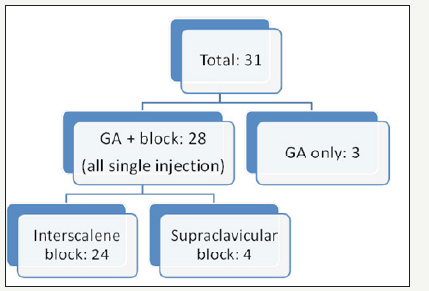Provision of Anaesthesia for Shoulder Surgery- A Case Load Analysis by Zhaosheng Jin* in Developments in Anaesthetics & Pain Management_ Developments in Anaesthetics & Pain Management

Abstract
Over the years a number of techniques have been
developed to address the postoperative analgesic requirement in shoulder
surgeries. The introduction of catheter based technique for interscalene block now enables
longer lasting analgesic effect and is now considered to be the gold standard
postoperative analgesia in complex shoulder surgery. However, its use is often
limited by the staffing and resources constraints. In this case load analysis,
we seek to investigate the anaesthetic practice of our busy district general hospital
and how it compares to the gold standard treatment.
Introduction
The shoulder is an anatomically complex joint
involving bone, cartilage, capsule, tendon and muscle. Pathology could develop
from any of these structure and lead to surgical intervention. In shoulder
surgery physiotherapy forms a vital part of the postoperative rehabilitation
however it is often limited by significant postoperative pain [1].
More recently a number of techniques have been
used to manage the postoperative pain in shoulder surgery, this include
intra-Articular local anaesthetics, supraclavicular axillary and interscalene
nerve blocks. It has been shown that interscalene and supraclavicular block in
shoulder surgery has been associated with significantly reduced Perioperative Opioid requirement and Opioid related adverse effects, as well as
significantly faster postoperative recovery [2-5]. However, the limitation of
such technique is the relatively short duration of its analgesic effect.
The development of the catheter based technique
for the interscalene block now allows for continuous administration of local
anaesthetic agent and as a consequence, a significantly longer analgesic
duration. In a number of clinical trials and metaanalysis, interscalene
catheter technique has been demonstrated to have significantly better analgesic
effect than single interscalene injection [6,7]. It is considered to be the
gold standard in terms of Perioperative analgesia for complex shoulder surgery.
However, due to the higher skill requirement for insertion of the catheter, as
well as need for 24-hours-a-day follow up service, its use is not widely
implemented. In this case load analysis, we will investigate how the resources
and anaesthetic practice of
our high throughput, publically funded district general hospital compare to the
gold standard treatment.
https://crimsonpublishers.com/dapm/fulltext/DAPM.000519.php
For
more Open access journals in Crimson Publishers,
Please
click on the link: https://crimsonpublishers.com/
For
more articles in Journal of Developments
in Anaesthetics & Pain Management,
Please
click on below link: https://crimsonpublishers.com/dapm/
Follow
On Publons: https://publons.com/publisher/6342/crimson-publishers/
Follow
On Linkedin: https://www.linkedin.com/company/crimsonpublishers/
High
impact journals in Crimson Publishers?
https://www.quora.com/What-are-the-high-impact-journals-in-Crimson-Publishers
Crimson
Publishers Journals
https://crimsonpublishers.com/



No comments:
Post a Comment